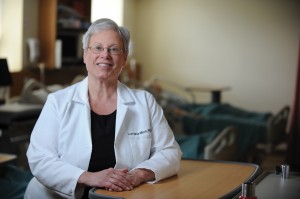
“Is this a house of corrections or a house of comfort?” asked the attending physician, a native of Britain, noting that American nurses have such strange practices, tethering their patients.
Those comments, delivered to a group on medical practice rounds that included a young Lorraine Mion, PhD, RN, FAAN, shaped the whole course of her research into the prevention of adverse consequences that occur during hospitalization for geriatric patients.
“The use of physical restraints is the antithesis of what we promote in good nursing practice. It was something we were doing because we believed it was doing good for our patient by preventing falls, but really we were doing more harm by forcing people to be tied down in their bed,” said Mion, now Independence Foundation Professor of Nursing at VUSN.
A fall can be devastating for a geriatric patient, resulting in injuries that severely impact their function and independence. One of the primary reasons given for using restraints is to prevent falls.
When the Joint Commission and Centers for Medicare & Medicaid Services (CMS) encouraged the use of bed alarms as a fall prevention measure, Mion knew from clinical observation that bed alarms malfunctioned frequently or created so many false alarms that nurses began to ignore them. A hospital study she conducted through the National Institutes on Aging revealed that nurses receiving frequent reminders to use bed alarms brought no difference in fall or fall injury rates.
The Institute for Healthcare Improvement created a list of fall risk indicators, which includes being 85 and older, osteoporosis, taking an anticoagulant or taking two or more antihypertensive medications. Mion took this list and compared it with 780 patients who fell, to test for a correlation of fall injury with IHI’s indicators. There was no significant relationship found in any of the indicators.
Mion says recommendations from governing bodies push for the use of more technology and intervention – the use of bed alarms or very low beds, for example – with little evidence to back up the additional energy and expense.
“It is really important that we examine our practices to determine the benefit, whether there were adverse consequences, and the cost,” said Mion.